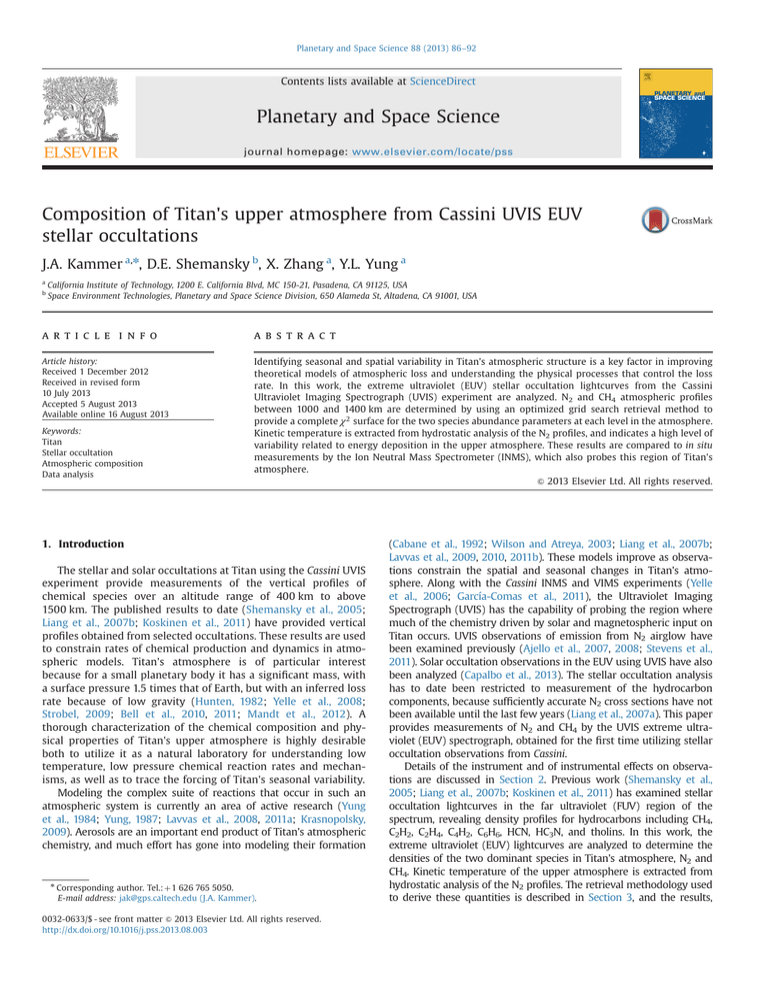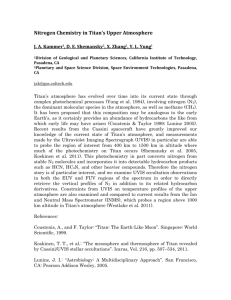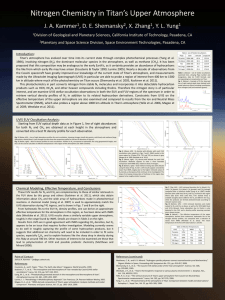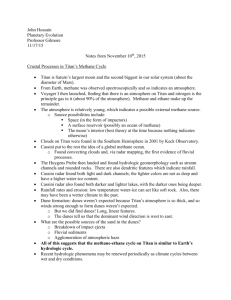
Planetary and Space Science 88 (2013) 86–92
Contents lists available at ScienceDirect
Planetary and Space Science
journal homepage: www.elsevier.com/locate/pss
Composition of Titan's upper atmosphere from Cassini UVIS EUV
stellar occultations
J.A. Kammer a,n, D.E. Shemansky b, X. Zhang a, Y.L. Yung a
a
b
California Institute of Technology, 1200 E. California Blvd, MC 150-21, Pasadena, CA 91125, USA
Space Environment Technologies, Planetary and Space Science Division, 650 Alameda St, Altadena, CA 91001, USA
art ic l e i nf o
a b s t r a c t
Article history:
Received 1 December 2012
Received in revised form
10 July 2013
Accepted 5 August 2013
Available online 16 August 2013
Identifying seasonal and spatial variability in Titan's atmospheric structure is a key factor in improving
theoretical models of atmospheric loss and understanding the physical processes that control the loss
rate. In this work, the extreme ultraviolet (EUV) stellar occultation lightcurves from the Cassini
Ultraviolet Imaging Spectrograph (UVIS) experiment are analyzed. N2 and CH4 atmospheric profiles
between 1000 and 1400 km are determined by using an optimized grid search retrieval method to
provide a complete χ 2 surface for the two species abundance parameters at each level in the atmosphere.
Kinetic temperature is extracted from hydrostatic analysis of the N2 profiles, and indicates a high level of
variability related to energy deposition in the upper atmosphere. These results are compared to in situ
measurements by the Ion Neutral Mass Spectrometer (INMS), which also probes this region of Titan's
atmosphere.
& 2013 Elsevier Ltd. All rights reserved.
Keywords:
Titan
Stellar occultation
Atmospheric composition
Data analysis
1. Introduction
The stellar and solar occultations at Titan using the Cassini UVIS
experiment provide measurements of the vertical profiles of
chemical species over an altitude range of 400 km to above
1500 km. The published results to date (Shemansky et al., 2005;
Liang et al., 2007b; Koskinen et al., 2011) have provided vertical
profiles obtained from selected occultations. These results are used
to constrain rates of chemical production and dynamics in atmospheric models. Titan's atmosphere is of particular interest
because for a small planetary body it has a significant mass, with
a surface pressure 1.5 times that of Earth, but with an inferred loss
rate because of low gravity (Hunten, 1982; Yelle et al., 2008;
Strobel, 2009; Bell et al., 2010, 2011; Mandt et al., 2012). A
thorough characterization of the chemical composition and physical properties of Titan's upper atmosphere is highly desirable
both to utilize it as a natural laboratory for understanding low
temperature, low pressure chemical reaction rates and mechanisms, as well as to trace the forcing of Titan's seasonal variability.
Modeling the complex suite of reactions that occur in such an
atmospheric system is currently an area of active research (Yung
et al., 1984; Yung, 1987; Lavvas et al., 2008, 2011a; Krasnopolsky,
2009). Aerosols are an important end product of Titan's atmospheric
chemistry, and much effort has gone into modeling their formation
n
Corresponding author. Tel.: þ1 626 765 5050.
E-mail address: jak@gps.caltech.edu (J.A. Kammer).
0032-0633/$ - see front matter & 2013 Elsevier Ltd. All rights reserved.
http://dx.doi.org/10.1016/j.pss.2013.08.003
(Cabane et al., 1992; Wilson and Atreya, 2003; Liang et al., 2007b;
Lavvas et al., 2009, 2010, 2011b). These models improve as observations constrain the spatial and seasonal changes in Titan's atmosphere. Along with the Cassini INMS and VIMS experiments (Yelle
et al., 2006; García-Comas et al., 2011), the Ultraviolet Imaging
Spectrograph (UVIS) has the capability of probing the region where
much of the chemistry driven by solar and magnetospheric input on
Titan occurs. UVIS observations of emission from N2 airglow have
been examined previously (Ajello et al., 2007, 2008; Stevens et al.,
2011). Solar occultation observations in the EUV using UVIS have also
been analyzed (Capalbo et al., 2013). The stellar occultation analysis
has to date been restricted to measurement of the hydrocarbon
components, because sufficiently accurate N2 cross sections have not
been available until the last few years (Liang et al., 2007a). This paper
provides measurements of N2 and CH4 by the UVIS extreme ultraviolet (EUV) spectrograph, obtained for the first time utilizing stellar
occultation observations from Cassini.
Details of the instrument and of instrumental effects on observations are discussed in Section 2. Previous work (Shemansky et al.,
2005; Liang et al., 2007b; Koskinen et al., 2011) has examined stellar
occultation lightcurves in the far ultraviolet (FUV) region of the
spectrum, revealing density profiles for hydrocarbons including CH4,
C2H2, C2H4, C4H2, C6H6, HCN, HC3N, and tholins. In this work, the
extreme ultraviolet (EUV) lightcurves are analyzed to determine the
densities of the two dominant species in Titan's atmosphere, N2 and
CH4. Kinetic temperature of the upper atmosphere is extracted from
hydrostatic analysis of the N2 profiles. The retrieval methodology used
to derive these quantities is described in Section 3, and the results,
J.A. Kammer et al. / Planetary and Space Science 88 (2013) 86–92
along with comparison to results from the Cassini Ion Neutral Mass
Spectrometer (INMS), are discussed in Section 4. Conclusions are
summarized in Section 5.
2. The UVIS instrument
2.1. FUV and EUV spectrographs
A full description of the UVIS experiment is contained in Esposito
et al. (2004), but the relevant components of interest for this work are
the EUV and FUV spectrographs. The spectral range of the spectrographs is 563–1182 Å (EUV) and 1115–1912 Å (FUV); these spectral
regions provide complementary atmospheric composition information
during simultaneous exposure. Stellar flux in the FUV region generally
can be detected down to observation tangent heights of about 400 km,
revealing the profiles of a wide range of hydrocarbons, including CH4,
C2H2, C2H4, C4H2, C6H6, HCN, HC3N, and tholins. On the other hand,
EUV stellar flux is largely absorbed at tangent heights of about
1000 km; however, observations in the EUV present the unique
opportunity to study N2, which does not have absorption features in
the FUV. The ionization continuum of methane in the EUV allows
extraction of the CH4 profile.
87
Table 1
Analyzed stellar occultations.
Titan flyby
T21
T35
T41
T41
Date (Year-Day)
2006-346
2007-243
2008-054
2008-054
Stellar target
Latitude
Longitude
Log N 0 (cm 3)
α Eri
35 S
116 W
s Sgr
35 S
329 W
ϵ CMa
4S
333 W
ϵ CMa
24 S
173 W
þ 0:90
20:170:90
þ 13:6
149:611:6
þ 0:96
16:470:69
þ 0:86
20:810:82
þ 0:96
21:860:98
Temperature (K)
þ 25:0
225:026:5
þ 10:1
136:99:7
þ 10:1
124:88:8
2.4. Occultation spatial/seasonal coverage
Over 20 Titan stellar occultation events were observed by the EUV
spectrograph from 2004 through 2010; of these, there are four stellar
occultations during Titan flybys T21, T35, and T41 that present stable
observations. The details of these occultations are shown in the first
part of Table 1. The occultation latitude and longitude are determined
based on the projection of observation geometry for tangent heights
(impact parameter) between 1000 and 1400 km; in this region these
projected values vary less than 1–21 due to trajectory motion during
the course of the observation.
3. Methodology
2.2. Instrument model
3.1. Forward model
Details for modeling of species abundances from the UVIS measurements are described by Shemansky et al. (2005) and Shemansky
and Liu (2012). The absorption spectra are forward modeled using a
high resolution blanketed model of the stellar source with simulation
of the instrument response to the source spectrum. The simulation
process includes analytic functions matching the wavelength dependent point spread functions (psf) that characterize the spectrographs.
The stellar model and simulation process are also described in
Chapter 9 of the Cassini UVIS User's Guide available in the NASAPDS (2012). Examples of the impact of the psf on the analysis are given
by Shemansky et al. (2005), Liang et al. (2007b), Shemansky and Liu
(2012). In the present work the filtered raw data is used to produce
the extinction profiles. The mechanics of the occultation process in the
Cassini spacecraft system is described in the supporting online
material of Shemansky et al. (2005). High resolution photoabsorption
cross sections for the N2X(0) state at a temperature of 150 K were
obtained from coupled channel calculations by Heays and Lewis (Liang
et al., 2007a). These cross sections were obtained with a resolving
power of 106 at increments of 1 cm 1. CH4 cross sections used in
the reduction process are taken from Kameta et al. (2002).
In order to retrieve the abundances of N2 and CH4 from each
spectrum that UVIS records during an observation, a forward model is
constructed that utilizes the species cross sections in the EUV. This
model simulates the instrument response to a calculated extinction
spectrum of the transmitted stellar source model through a model
atmosphere, as described in Section 2.2.
The generation of a reference database allows for fast and efficient
forward modeling of species abundances ðηs Þ to optical depth ðτλ Þ in
the EUV. In this case, the database includes a tabulated grid of values
for both N2 and CH4, at 50 line of sight abundances ranging from
η ¼ 1014 –1019 cm 2, and 512 wavelength values corresponding to
the UVIS windowed EUV mode (λ ¼ 870–1180 Å). This database is
represented by
2.3. Spacecraft pointing issues
The accuracy of the extinction spectrum in occultation observations, apart from photon counting statistics, is limited by the
stability of instrument pointing. Normally the spacecraft reaction
wheels retain pointing well within the limits required for accurate
spectral records. During flybys of Titan, however, transitions are
necessary between thruster and reaction wheel control, and
observations may occur in a transition period, introducing instability in the position of the image on the detector. These events
significantly affect the process of obtaining accurate extinction
spectra. While it may yet be possible to correct for these shifts in
flux, the effects are highly nonlinear, and thus the initial analysis of
occultation data is limited to cases where little or no pointing
issues occur. These cases are presented below in Section 2.4.
τλ ¼ τλ ðηN2 ; ηCH4 Þ
ð1Þ
A spectrum corresponding to the clear atmosphere view of the
target star is obtained from instrument observations taken above
an impact parameter of 1800 km. This I0 spectrum completes the
forward model in the follow equation:
I λ ¼ I 0;λ expðτλ Þ
ð2Þ
Statistical uncertainty in the I0 spectrum is determined by calculating the standard deviation at each wavelength of the observations
made above 1800 km. Fig. 1 shows an example of the I0 spectrum and
the standard deviation for Titan flyby T41-I during the occultation of
the star ϵ CMa, as well as a sample spectrum taken deeper into the
atmosphere.
3.2. Retrieval algorithm
In a multivariate system with a forward model containing many
independent parameters, it becomes computationally infeasible to
conduct a brute force grid search in order to determine the
marginalized posterior likelihoods for each variable in a χ 2 sense.
Such is the case for previous examinations of UVIS spectra in the
FUV (Koskinen et al., 2011); in order to simultaneously fit for many
different hydrocarbon species, a Levenberg–Marquardt routine
88
J.A. Kammer et al. / Planetary and Space Science 88 (2013) 86–92
Fig. 1. Intensity and optical depth spectra during occultation T41-I. The top panel shows the I0 stellar flux, taken as the median of all 5-second integrated records at tangent
heights above 1800 km. Error bars are the associated standard deviation of the flux. The middle panel shows the equivalent spectrum at a height of 1092 km, with stellar flux
(black) compared to the best fit model (red). The bottom panel provides the same comparison using optical depth units. (For interpretation of the references to color in this
figure caption, the reader is referred to the web version of this article.)
was adopted similar to that of Rodgers (2000). This routine and
similar ones take advantage of the assumption of Gaussian parameter uncertainties in order to speed up calculations, and in
general provide the fastest retrieval. Other statistical studies have
also experimented with the use of Markov Chain Monte Carlo
(MCMC) algorithms and their derivatives (Andrieu et al., 2003),
which can be computationally intensive but are beneficial
in situations where an assumption of Gaussian uncertainties is
invalid.
For this work there are only two parameters adjusted in the
forward model: ηN2 and ηCH4 . This computational advantage,
combined with a highly parallelized grid search retrieval code,
allows for a complete determination of the two parameter χ 2
surface for combinations of N2 and CH4 abundances at each level
in the atmosphere. This avoids making any assumptions about the
shape of parameter uncertainties, and is therefore a more robust
method for estimating the uncertainty in retrieved column densities than assuming Gaussian errors. An example of a retrieved
reduced χ 2 contour map is shown in Fig. 2. Reduced χ 2 is
equivalent to χ 2 =ν, where ν is the number of degrees of freedom,
given as N n where N is the number of data points and n is the
number of fitted model parameters. In this case, N ¼ 512 and n ¼2,
thus ν ¼ 510.
3.3. Conversion from abundance to density profiles
Once the χ 2 surface has been calculated, the marginalized
posterior likelihoods for each parameter can be obtained by
projecting the total χ 2 along each parameter axis. Several examples of these marginalized posteriors at different heights are
shown in Fig. 3. These distributions are then used to calculate
the best fit pair of parameters, along with their corresponding 1s
uncertainties.
Though approximately Gaussian in shape, the N2 posterior
probability distributions are asymmetric near the top and bottom
Fig. 2. Contour map showing example of two parameter grid search method to
determine the reduced χ 2 surface. Grid resolution for each parameter is 0.01 in log
abundance space. This fit is for flyby T41-I at an occultation tangent height of
1092 km. The process is repeated for each tangent height made during the
observation.
of the observation region. Above about 1500 km, there is only
enough absorption to provide upper limit constraints; likewise, as
tangent heights of 1000 km are reached, too few EUV photons
remain to constrain N2.
The initial retrieved values, in physical terms, are line of sight
column abundances – an example of a full profile of N2 and CH4
abundances is shown in Fig. 4. In order to make the conversion from
J.A. Kammer et al. / Planetary and Space Science 88 (2013) 86–92
89
Fig. 3. Comparison between tangent heights. Shown are the marginalized posterior likelihood distributions (black) for the abundances of both N2 and CH4 during occultation
T41-I. The three curves correspond to three different levels in Titan's atmosphere: 1457 km (dash-dotted line, left), 1193 km (dashed line, middle), and 1010 km (solid line,
right). The red, dotted curves are best fit Gaussian distributions in log space. (For interpretation of the references to color in this figure caption, the reader is referred to the
web version of this article.)
Fig. 4. Retrieved line of sight abundances. Shown here is the profile of N2 (black),
and CH4 (red) for occultation during T41-I. Methane abundances are highly
constrained, while nitrogen is less so. (For interpretation of the references to color
in this figure caption, the reader is referred to the web version of this article.)
abundances to densities, spherical symmetry of the atmosphere is
assumed such that the well-known inverse Abel transform may be
applied, as in below:
ρðr Þ ¼ 1
π
Z
1
r
dη dh
pffiffiffiffiffiffiffiffiffiffiffiffiffi
dh h2 r 2
ð3Þ
In this case, ρðrÞ is the local density as a function of the distance
from Titan's center, r; ηðhÞ is the retrieved line of sight abundance
as a function of the tangent height, h, also calculated as distance
from Titan's center. The limits of integration extend to infinity, but
the UVIS measurements generally only begin or end at tangent
heights of approximately 2000 km or so above the surface of
Titan; a method of extrapolation is needed to account for the
unobserved atmosphere above this region, therefore a simple
exponential decrease with altitude is fit to the observed data. It
should be noted that the sensitivity of the retrieved density
profiles to this extrapolation region is minimal, and its use is
primarily to avoid nonphysical solutions.
The species density uncertainties at each altitude are determined using a series of 1000 random draws from the abundance
posterior distributions in order to propagate the calculated parameter uncertainties. This creates a set of 1000 density profiles,
which represent at each altitude the propagated uncertainty in
species density. The median of this distribution is taken as the best
fit solution, and the 68% confidence interval represents the 1s
Fig. 5. Calculated species density profiles and isothermal fit. Density is determined
from the retrieved line of sight abundances using the inverse Abel transform of Eq.
(3). Here again, the best fit N2 profile is shown in black, with the associated 1s
uncertainty; corresponding profiles for CH4 are shown in red. The isothermal,
hydrostatic model (orange) is fit to N2 density and used to calculate the effective
temperature in this region of Titan's upper atmosphere. (For interpretation of the
references to color in this figure caption, the reader is referred to the web version of
this article.)
uncertainty. An example of the resulting profile, including the best
fit densities and their 1s uncertainties, is shown in Fig. 5.
3.4. Effective temperatures from fits to N2 scale height
In addition to retrieved atmospheric composition in terms of
N2 and CH4 densities, the effective temperature of this region of
Titan's atmosphere can also be determined assuming a constant
scale height, Hs, with altitude. This is essentially identical to a
procedure performed using Cassini Ion Neutral Mass Spectrometer
(INMS) data by Westlake et al. (2011). Because the effect of gravity
cannot be assumed constant in this region of Titan's atmosphere,
the altitude used in the scale height fit is replaced with a surface
referenced geopotential height, simplifying the calculation. Thus
z¼
h
1 þ h=RTitan
Hs ¼
kT eff
ms g 0
Ns ðzÞ ¼ N s;0 expðz=H s Þ
ð4Þ
ð5Þ
ð6Þ
90
J.A. Kammer et al. / Planetary and Space Science 88 (2013) 86–92
Fig. 6. Ensemble of results for each occultation. Retrieved line of sight abundances, calculated densities for N2 (black) and CH4 (red), and isothermal model fits (orange) for
Titan flybys T21, T35, T41-I, and T41-II (in rows 1–4 respectively). (For interpretation of the references to color in this figure caption, the reader is referred to the web version
of this article.)
In Eq. (4), z is the geopotential height, h is the altitude, and
RTitan is the radius of Titan. In Eq. (5), the scale height Hs is
determined by k, Boltzmann's constant; Teff, the effective temperature; ms, the mass of species s; and g0, the gravitational
acceleration at the surface of Titan. Lastly, in Eq. (6), the species
number density Ns as a function of geopotential height is assumed
hydrostatic and isothermal with a parametrized surface number
density Ns;0 , allowed to vary in the fit. An example of the model fit
to the data is also shown in Fig. 5.
4. Results and discussion
4.1. Retrieved abundance and density profiles
The results of analysis for all stellar occultations examined in
this work are shown in Fig. 6. The abundances and their marginalized posterior likelihood distributions are used directly to
calculate local densities at each altitude level between 1000 and
1400 km. While global coverage of UVIS EUV occultation data sets
J.A. Kammer et al. / Planetary and Space Science 88 (2013) 86–92
91
previously suggested by Westlake et al. (2011) using in situ results
from INMS.
Acknowledgments
This research was supported in part by the Cassini UVIS program
via NASA Grant JPL.1459109 to the California Institute of Technology.
YLY and XZ were supported in part by NASA Grant NNX09AB72G to
the California Institute of Technology. DES was supported through
Space Environment Technologies. JAK would like to thank Michael
Line for many productive discussions concerning data analysis and
retrieval methodology, as well as Joseph Westlake for assistance in
providing INMS derived nitrogen and methane atmospheric profiles.
Fig. 7. Comparison with INMS results. Plotted are the mean values of the four N2
(black) and CH4 (red) density profiles retrieved from the stellar occultation
examined in this work, along with their associated range of uncertainties. Density
profiles for N2 and CH4 from 29 flybys of INMS are shown in gray and light red,
respectively (Westlake et al., 2011). (For interpretation of the references to color in
this figure caption, the reader is referred to the web version of this article.)
is relatively limited, results from measurements by Cassini INMS
have revealed in situ densities for 29 Titan flybys (Westlake et al.,
2011). This allows for density retrievals from UVIS to be understood in a broader context. For instance, even among a small
number of UVIS observations, there appears to be a significant
amount of variability in the density profiles; such variability is also
strongly indicated in the INMS data (Cui et al., 2009, 2012; Magee
et al., 2009; Westlake et al., 2011). Fig. 7 shows the comparison
between this work and the collective results from 29 flybys
of INMS.
4.2. Effective temperatures
Model fits of isothermal, hydrostatic nitrogen profiles for each
stellar occultation examined in this work are also shown in Fig. 6.
Effective temperatures and their uncertainties are shown in the second
part of Table 1. While too few in number to examine any possible
correlation with plasma environments as in Westlake et al. (2011), the
UVIS results still show significant variability, including an effective
temperature difference of nearly 100 K between flybys T35 and T41. It
is important to note, however, that while this effective temperature
calculation reveals trends for the upper atmosphere as a whole,
temperature cannot be constant starting at 1000 km; this is the
location of the ionospheric peak where the heating profile has a large
slope. Future work is needed to extract non-isothermal temperature
profiles.
5. Conclusions
Stellar occultation observations from Cassini UVIS have confirmed
Titan's upper atmosphere to be a dynamic environment. Analysis of
data from the instrument's EUV spectrograph complement those
previously derived from the FUV, and provide context for the bulk
atmospheric properties of the upper atmosphere. Though limited by
the effect of pointing instability, a selected number of occultation
measurements allow for additional constraints to be made on the
profiles of N2 and CH4, as well as on the effective temperatures of the
upper atmosphere between 1000 and 1400 km. The results show that
even averaged over thousands of kilometers, the columns N2 and CH4
exhibit large variabilities. The apparent changes observed in these
physical parameters may indicate spatial and seasonal differences in
the deposition of energy, perhaps driven by magnetospheric input as
References
Ajello, J., Stevens, M., Stewart, I., Larsen, K., Esposito, L., Colwell, J., McClintock, W.,
Holsclaw, G., Gustin, J., Pryor, W., 2007. Titan airglow spectra from the Cassini
ultraviolet imaging spectrograph (UVIS): EUV analysis. Geophysical Research
Letters 34, L24204.
Ajello, J.M., Gustin, J., Stewart, I., Larsen, K., Esposito, L., Pryor, W., McClintock, W.,
Stevens, M.H., Malone, C.P., Dziczek, D., 2008. Titan airglow spectra from the
Cassini ultraviolet imaging spectrograph: FUV disk analysis. Geophysical
Research Letters 35.
Andrieu, C., De Freitas, N., Doucet, A., Jordan, M., 2003. An introduction to MCMC
for machine learning. Machine learning 50, 5–43.
Bell, J.M., Bougher, S.W., Waite, J.H., Ridley, A.J., Magee, B.A., Mandt, K.E., Westlake,
J., DeJong, A.D., Bar-Nun, A., Jacovi, R., et al., 2011. Simulating the onedimensional structure of Titan's upper atmosphere: 3. mechanisms determining methane escape. Journal of Geophysical Research: Planets (1991–2012) 116.
Bell, J.M., Bougher, S.W., Waite, J.H., Ridley, A.J., Magee, B.A., Mandt, K.E., Westlake,
J., DeJong, A.D., De La Haye, V., Bar-Nun, A., et al., 2010. Simulating the onedimensional structure of Titan's upper atmosphere: 2. alternative scenarios for
methane escape. Journal of Geophysical Research: Planets (1991–2012) 115.
Cabane, M., Chassefiere, E., Israel, G., 1992. Formation and growth of photochemical
aerosols in Titan's atmosphere. Icarus 96, 176–189.
Capalbo, F.J., Bénilan, Y., Yelle, R.V., Koskinen, T.T., Sandel, B.R., Holsclaw, G.M.,
McClintock, W.E., 2013. Solar occultation by titan measured by Cassini/UVIS.
The Astrophysical Journal Letters 766, L16.
Cui, J., Yelle, R., Strobel, D., Müller-Wodarg, I., Snowden, D., Koskinen, T., Galand, M.,
2012. The CH4 structure in Titan's upper atmosphere revisited. Journal of
Geophysical Research: Planets (1991–2012) 117.
Cui, J., Yelle, R., Vuitton, V., Waite Jr, J., Kasprzak, W., Gell, D., Niemann, H., MüllerWodarg, I., Borggren, N., Fletcher, G., et al., 2009. Analysis of titan's neutral
upper atmosphere from Cassini ion neutral mass spectrometer measurements.
Icarus 200, 581–615.
Esposito, L., Barth, C., Colwell, J., Lawrence, G., McClintock, W., Stewart, A., Uwe Keller, H.,
Korth, A., Lauche, H., Festou, M., et al., 2004. The Cassini ultraviolet imaging
spectrograph investigation, in: The Cassini–Huygens Mission, pp. 299–361.
García-Comas, M., López-Puertas, M., Funke, B., Dinelli, B.M., LuisaMoriconi, M.,
Adriani, A., Molina, A., Coradini, A., 2011. Analysis of Titan CH4 3:3 μm upper
atmospheric emission as measured by Cassini/VIMS. Icarus 214, 571–583.
Hunten, D.M., 1982. Thermal and nonthermal escape mechanisms for terrestrial
bodies. Planetary and Space Science 30, 773–783.
Kameta, K., Kouchi, N., Ukai, M., Hatano, Y., 2002. Photoabsorption, photoionization,
and neutral-dissociation cross sections of simple hydrocarbons in the vacuum
ultraviolet range. Journal of Electron Spectroscopy and Related Phenomena 123,
225–238.
Koskinen, T., Yelle, R., Snowden, D., Lavvas, P., Sandel, B., Capalbo, F., Benilan, Y.,
West, R., 2011. The mesosphere and lower thermosphere of Titan revealed by
Cassini/UVIS stellar occultations. Icarus 216, 507–534.
Krasnopolsky, V., 2009. A photochemical model of Titan's atmosphere and ionosphere. Icarus 201, 226–256.
Lavvas, P., Coustenis, A., Vardavas, I., 2008. Coupling photochemistry with haze
formation in titan's atmosphere, part i: model description. Planetary and Space
Science 56, 27–66.
Lavvas, P., Galand, M., Yelle, R., Heays, A., Lewis, B., Lewis, G., Coates, A., 2011a.
Energy deposition and primary chemical products in Titan's upper atmosphere.
Icarus 213, 233–251.
Lavvas, P., Sander, M., Kraft, M., Imanaka, H., 2011b. Surface chemistry and particle
shape: processes for the evolution of aerosols in Titan's atmosphere. The
Astrophysical Journal 728, 80.
Lavvas, P., Yelle, R., Griffith, C., 2010. Titan's vertical aerosol structure at the
Huygens landing site: constraints on particle size, density, charge, and
refractive index. Icarus 210, 832–842.
Lavvas, P., Yelle, R., Vuitton, V., 2009. The detached haze layer in Titan's mesosphere. Icarus 201, 626–633.
Liang, M., Heays, A., Lewis, B., Gibson, S., Yung, Y., 2007a. Source of nitrogen isotope
anomaly in HCN in the atmosphere of titan. The Astrophysical Journal Letters
664, L115.
92
J.A. Kammer et al. / Planetary and Space Science 88 (2013) 86–92
Liang, M., Yung, Y., Shemansky, D., 2007b. Photolytically generated aerosols in the
mesosphere and thermosphere of titan. The Astrophysical Journal Letters 661, L199.
Magee, B., Waite, J., Mandt, K., Westlake, J., Bell, J., Gell, D., 2009. INMS-derived
composition of Titan's upper atmosphere: analysis methods and model
comparison. Planetary and Space Science 57, 1895–1916.
Mandt, K.E., Waite, J.H., Teolis, B., Magee, B.A., Bell, J., Westlake, J.H., Nixon, C.A.,
Mousis, O., Lunine, J.I., 2012. The 12C/13C ratio on titan from Cassini INMS
measurements and implications for the evolution of methane. The Astrophysical Journal 749, 160.
NASA-PDS, 2012. Cassini UVIS User's Guide. Planetary Data System. ⟨http://
pds-rings.seti.org/cassini/uvis/index.html⟩.
Rodgers, C., 2000. Inverse Methods for Atmospheric Sounding. World Scientific.
Shemansky, D., Liu, X., 2012. Saturn upper atmospheric structure from Cassini EUV
and FUV occultations. Canadian Journal of Physics 90, 817–831.
Shemansky, D., Stewart, A., West, R., Esposito, L., Hallett, J., Liu, X., 2005. The Cassini
UVIS stellar probe of the titan atmosphere. Science 308, 978–982.
Stevens, M., Gustin, J., Ajello, J., Evans, J., Meier, R., Kochenash, A., Stephan, A.,
Stewart, A., Esposito, L., McClintock, W., et al., 2011. The production of Titan's
ultraviolet nitrogen airglow. Journal of Geophysical Research 116, A05304.
Strobel, D., 2009. Titan's hydrodynamically escaping atmosphere: escape rates and
the structure of the exobase region. Icarus 202, 632–641.
Westlake, J., Bell, J., Waite Jr, J., Johnson, R., Luhmann, J., Mandt, K., Magee, B.,
Rymer, A., 2011. Titan's thermospheric response to various plasma environments. Journal of Geophysical Research 116, A03318.
Wilson, E., Atreya, S., 2003. Chemical sources of haze formation in Titan's atmosphere. Planetary and Space Science 51, 1017–1033.
Yelle, R., Borggren, N., De La Haye, V., Kasprzak, W., Niemann, H., Müller-Wodarg, I.,
Waite, J., 2006. The vertical structure of Titan's upper atmosphere from Cassini
ion neutral mass spectrometer measurements. Icarus 182, 567–576.
Yelle, R., Cui, J., Müller-Wodarg, I., 2008. Methane escape from titan's atmosphere.
Journal of Geophysical Research 113, E10003.
Yung, Y., 1987. An update of nitrile photochemistry on Titan. Icarus 72, 468–472.
Yung, Y., Allen, M., Pinto, J., 1984. Photochemistry of the atmosphere of Titan—
comparison between model and observations. The Astrophysical Journal
Supplement Series 55, 465–506.






